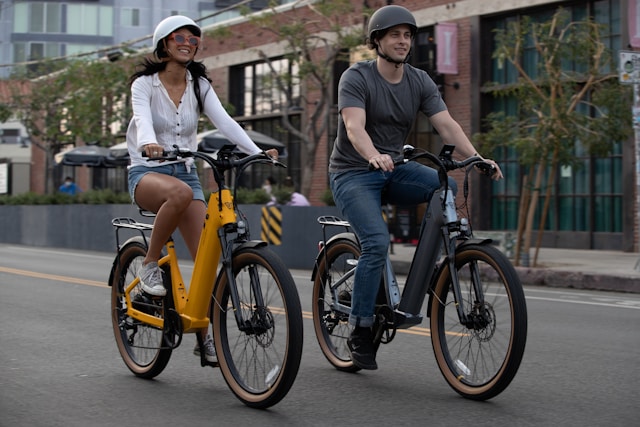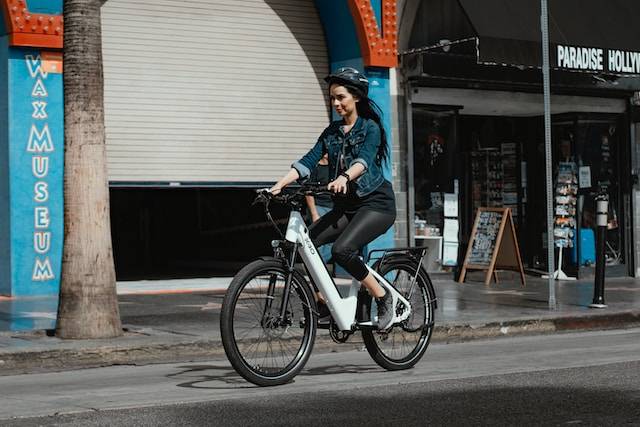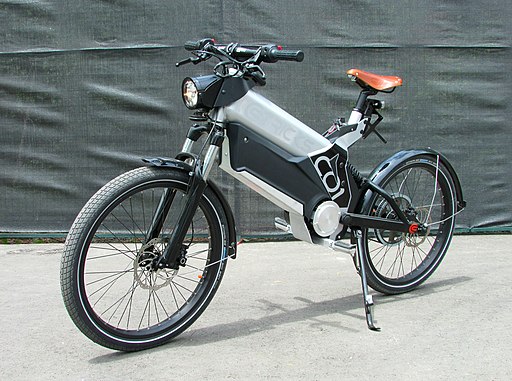Choosing the Perfect Electric Commuter Bike
In recent years, the landscape of urban transportation has witnessed a significant shift towards sustainable and efficient alternatives. Among these emerging options, electric commuter bikes have garnered substantial attention and adoption. As cities grow and traffic congestion becomes more pronounced, commuters are seeking practical solutions that not only reduce their carbon footprint but also offer convenience and reliability. Electric commuter bikes have swiftly emerged as a viable solution, blending the convenience of cycling with the added boost of electric assistance.
Choosing the right electric commuter bike is not merely a matter of selecting the most visually appealing or technologically advanced model. It’s a decision that profoundly impacts your daily commute, your lifestyle, and even your environmental footprint. This introduction aims to underscore the importance of navigating the vast array of electric commuter bikes available on the market with a discerning eye, ensuring that your investment aligns seamlessly with your unique needs and preferences.
From navigating bustling city streets to embarking on scenic routes, the electric commuter bike you choose can significantly influence your commuting experience. Whether you’re a seasoned cyclist or a newcomer to the world of electric bikes, understanding the key considerations and features outlined in this guide will empower you to make an informed decision—one that enhances both your daily routine and your overall well-being.
Key Takeaways
- Prioritize Comfort and Fit:
- Optimal comfort and fit are paramount for enjoying your electric commuter bike to the fullest. Choose a bike with ergonomic design features and adjustable components to ensure a comfortable riding position and minimize strain on your body during long commutes.
- Consider Range and Power:
- Assess your commuting needs and select an electric bike with an appropriate range and power level to meet your requirements. Consider factors such as distance, terrain, and expected assistance levels to ensure your bike can handle your daily commute with ease.
- Test Ride Multiple Bikes:
- Before making a final decision, take the time to test ride multiple electric commuter bikes to find the best match for your preferences and riding style. Pay attention to factors such as handling, responsiveness, and overall comfort to make an informed choice.
- Factor in Additional Costs:
- When budgeting for your electric commuter bike, don’t forget to consider additional expenses such as accessories and maintenance costs. Factor in the price of essential accessories like lights, racks, and locks, as well as ongoing maintenance and repair expenses to ensure you’re fully prepared.
- Research User Reviews and Expert Opinions:
- Take advantage of user reviews and expert opinions to gather insights and feedback on different electric commuter bike models. Explore online forums, review websites, and manufacturer resources to gain valuable perspectives and make a well-informed decision.
- Regular Maintenance is Key:
- To maximize the lifespan and performance of your electric commuter bike, prioritize regular maintenance and care. Keep your bike clean, lubricated, and properly adjusted, and address any issues promptly to prevent further damage or deterioration.
- Stay Informed about Regulations and Safety Guidelines:
- Familiarize yourself with local regulations and safety guidelines governing the use of electric bikes in your area. Stay informed about any restrictions, requirements, or recommendations to ensure you ride safely and responsibly on city streets and bike paths.
Why Choose an Electric Commuter Bike
In the bustling landscape of urban transportation, where time is of the essence and sustainability is paramount, electric commuter bikes emerge as a transformative solution. Let’s delve into the multifaceted benefits that make these bikes a compelling choice for modern commuters.
Environmental Benefits:
Electric commuter bikes represent a green alternative to traditional modes of transportation, offering an eco-friendly way to navigate city streets. By opting for electric bikes over conventional vehicles, commuters contribute to reduced carbon emissions and help alleviate the environmental burden associated with fossil fuel consumption. With each pedal-assisted journey, riders play a part in promoting cleaner air and mitigating the harmful effects of urban pollution, making a tangible difference in their local communities and beyond.
Cost Savings:
Beyond their environmental impact, electric commuter bikes offer substantial financial savings over time. Compared to owning and maintaining a car, the operational costs of electric bikes are significantly lower. Commuters can bypass expenses such as fuel, parking fees, and vehicle maintenance, reallocating those funds toward other priorities. Additionally, many cities offer incentives and subsidies to encourage the adoption of electric transportation, further enhancing the cost-effectiveness of electric commuter bikes for savvy urban dwellers.
Health Advantages:
The health benefits of cycling are well-documented, and electric commuter bikes amplify these advantages by providing a more accessible and inclusive riding experience. With electric assistance, riders can conquer challenging terrain and longer distances with ease, promoting physical activity and cardiovascular health. Commuting via electric bike also offers a convenient opportunity to incorporate exercise into daily routines, reducing sedentary behaviors associated with traditional modes of transportation. By prioritizing active transportation, commuters can reap the rewards of improved fitness, enhanced mental well-being, and a heightened sense of vitality.
Choosing an electric commuter bike transcends mere transportation—it embodies a conscious commitment to sustainability, fiscal responsibility, and personal wellness. By embracing the transformative potential of electric bikes, commuters can embark on a journey that not only enriches their daily lives but also contributes to a greener, healthier future for generations to come.
RELATED CONTENT – 5 Reasons Why Electric Bikes Are Perfect for Commuting
RELATED CONTENT – Mokwheel Asphalt Electric Bike Review
Electric Commuter Bike Reviews
In the rapidly expanding market of electric commuter bikes, choosing the perfect model can be a daunting task. To simplify your search, let’s explore five top-rated electric commuter bikes, highlighting their standout features, pros, and cons, as well as incorporating user experiences and ratings to provide a comprehensive overview.
Rad Power Bikes RadCity
- Overview: The RadCity from Rad Power Bikes is a versatile electric commuter bike designed for urban exploration. With a sturdy frame, powerful motor, and extensive range, it’s well-suited for daily commuting and weekend adventures alike.
- Features:
- 750W geared hub motor
- Long-lasting 48V battery with up to 45+ miles range
- Step-thru or step-over frame options for easy mounting
- Integrated rear rack and fenders for cargo carrying and all-weather riding
- Pros:
- Exceptional value for money
- Comfortable riding position and adjustable components
- Reliable performance and customer service
- Cons:
- Heavier than some competitors
- Limited color options
- User Review Statements:
- “The RadCity has transformed my daily commute. I love the power and range it offers, and the step-thru frame makes it a breeze to ride in the city.”
- “Great bike for the price. It’s sturdy, comfortable, and handles well on different terrains.”
- Price Range: $1,499 – $1,699
- Where to Buy: Rad Power Bikes website
Riese & Müller Supercharger
- Overview: The Riese & Müller Supercharger is a premium electric commuter bike renowned for its exceptional craftsmanship and cutting-edge technology. With customizable configurations and superior performance, it’s a top choice for discerning riders seeking luxury and reliability.
- Features:
- Bosch Performance Line CX motor with dual battery option
- Rohloff or Enviolo continuously variable transmission
- Suspension fork and ergonomic grips for enhanced comfort
- Integrated front and rear lights for safety and visibility
- Pros:
- High-quality components and build construction
- Smooth and powerful motor performance
- Customization options for frame style, drivetrain, and accessories
- Cons:
- Premium price point may be prohibitive for some buyers
- Complex assembly and maintenance requirements
- User Review Statements:
- “The Supercharger is in a league of its own. It’s the most comfortable and reliable electric bike I’ve ever owned, and the dual battery option ensures I never run out of power on long rides.”
- “Expensive but worth every penny. The attention to detail and ride quality are unmatched.”
- Price Range: $5,000 – $8,000+
- Where to Buy: Riese & Müller website
Gazelle Ultimate T10+
- Overview: The Gazelle Ultimate T10+ is a sleek and stylish electric commuter bike that combines Dutch design with cutting-edge technology. With a focus on comfort and functionality, it’s an ideal choice for urban riders seeking a premium riding experience.
- Features:
- Bosch Performance Line motor with smooth power delivery
- Enviolo continuously variable transmission for effortless shifting
- Fully integrated battery and wiring for a clean aesthetic
- Comfort-oriented design with adjustable stem and suspension fork
- Pros:
- Elegant design and attention to detail
- Smooth and quiet motor performance
- High-quality components and build construction
- Cons:
- Price may be prohibitive for budget-conscious buyers
- Limited availability in some regions
- User Review Statements:
- “The Gazelle Ultimate T10+ is a joy to ride. It’s comfortable, responsive, and feels incredibly stable on city streets.”
- “The attention to detail on this bike is impressive. From the integrated lighting to the adjustable stem, every aspect of the design feels well thought out.”
- Price Range: $3,000 – $4,000
- Where to Buy: Gazelle website
Specialized Turbo Vado
- Overview: The Specialized Turbo Vado is a high-performance electric commuter bike designed for urban exploration and daily commuting. With a sleek design, responsive motor, and intuitive features, it offers a seamless riding experience for riders of all skill levels.
- Features:
- Specialized 1.2E motor with smooth and silent operation
- Turbo Connect Display for easy access to ride data and assistance levels
- Future Shock suspension system for enhanced comfort on rough roads
- Integrated racks and fenders for carrying cargo and riding in all conditions
- Pros:
- Responsive and powerful motor performance
- Intuitive and user-friendly interface
- Versatile design with integrated accessories for practicality
- Cons:
- Higher price point compared to some competitors
- Limited color options and customization
- User Review Statements:
- “The Turbo Vado is a game-changer for my daily commute. It’s fast, smooth, and handles like a dream in city traffic.”
- “Specialized has nailed it with the Turbo Vado. It’s the perfect combination of style, performance, and practicality.”
- Price Range: $3,000 – $4,000
- Where to Buy: Specialized website
Trek Allant+
- Overview: The Trek Allant+ is a versatile electric commuter bike that excels in both urban environments and recreational rides. With a lightweight frame, powerful motor, and intuitive features, it offers a dynamic riding experience for commuters and enthusiasts alike.
- Features:
- Bosch Performance Line motor for smooth and reliable assistance
- Removable integrated battery for easy charging and security
- Shimano hydraulic disc brakes for confident stopping power
- Versatile design with mounting points for racks and accessories
- Pros:
- Lightweight and agile for nimble urban riding
- Dependable motor performance with responsive assistance levels
- Trusted brand reputation and customer support
- Cons:
- Limited availability of some sizes and colors
- Basic display interface compared to some competitors
- User Review Statements:
- “The Allant+ is a joy to ride. It’s responsive, comfortable, and handles beautifully on city streets and bike paths.”
- “Trek has hit a home run with the Allant+. It’s the perfect balance of performance, reliability, and affordability.”
- Price Range: $2,500 – $3,500
- Where to Buy: Trek website
These top-rated electric commuter bikes offer a range of options to suit different preferences and budgets, providing riders with a reliable and efficient means of urban transportation. Whether you prioritize style, performance, or practicality, there’s a perfect electric commuter bike waiting to elevate your daily commute.
RELATED CONTENT – Ultimate Guide to Electric Bike Commuting
RELATED CONTENT – Overcoming Common Challenges with Electric Bike Commuting
How to Choose an Electric Commuter Bike
Choosing the perfect electric commuter bike requires careful consideration of various factors to ensure it aligns seamlessly with your individual needs and preferences. Let’s explore a step-by-step guide to help you navigate this important decision with confidence:
1. Research and Budgeting:
- Begin by researching the available options in your budget range. Electric commuter bikes come in a wide range of prices, so it’s essential to establish a realistic budget based on your financial means.
- Consider additional costs such as accessories, maintenance, and potential upgrades when setting your budget to ensure you’re fully prepared for the total investment.
2. Consider Commuting Distance and Terrain:
- Evaluate your typical commuting distance and the terrain you’ll encounter along your route. Factors such as hills, rough roads, and bike paths will influence the type of electric commuter bike that best suits your needs.
- Choose a bike with an appropriate motor power and battery range to comfortably tackle your daily commute without running out of power midway.
3. Test Rides and Bike Fitting:
- Visit local bike shops or attend demo events to test ride different electric commuter bike models. Pay attention to how each bike feels in terms of comfort, handling, and responsiveness.
- Ensure proper bike fitting by adjusting the saddle height, handlebar position, and other components to optimize your riding position and comfort. A well-fitted bike can significantly enhance your riding experience and prevent discomfort or injury.
4. Assessing Battery Range and Power:
- Assess the battery range and power of each electric commuter bike to ensure it meets your commuting needs. Consider factors such as your typical riding distance, terrain, and desired level of assistance.
- Look for bikes with reliable battery performance and sufficient range to cover your daily commute with a margin for unexpected detours or longer rides.
5. Evaluating Comfort and Ergonomics:
- Prioritize comfort and ergonomics when selecting an electric commuter bike. Look for features such as adjustable handlebars, suspension forks, and ergonomic grips to minimize fatigue and discomfort during long rides.
- Pay attention to the bike’s overall design and geometry to ensure it suits your body type and riding style. A comfortable and ergonomic bike will encourage you to ride more frequently and enjoy your commute to the fullest.
It’s essential to emphasize the importance of matching the electric commuter bike to the rider’s specific needs and preferences. Every commuter is unique, and the perfect bike for one person may not necessarily be the best choice for another. By carefully considering factors such as budget, commuting distance, terrain, comfort, and battery performance, you can confidently select an electric commuter bike that enhances your daily commute and fits seamlessly into your lifestyle.
RELATED CONTENT – Can You Take an Electric Bike on a Train?
RELATED CONTENT – How Does the Cost of Owning an Ebike Compare to a Car or Regular Bike?
Electric Bike vs Regular Bike for Commuting
When it comes to commuting, the choice between an electric bike and a regular bike hinges on various factors that cater to individual preferences, needs, and circumstances. Let’s explore the key differences and considerations between the two options:
1. Speed and Convenience:
- Electric bikes offer the advantage of motor-assisted propulsion, allowing riders to travel faster and cover longer distances with less effort compared to traditional bikes. This increased speed and efficiency can be particularly beneficial for commuters with lengthy or challenging routes.
- Regular bikes rely solely on human power, requiring riders to exert physical effort to propel themselves forward. While this offers a great workout and promotes physical fitness, it may result in slower travel times and increased fatigue, especially on hilly terrain or during inclement weather.
2. Cost:
- Electric bikes typically come with a higher upfront cost compared to traditional bikes due to the added expense of the motor, battery, and associated components. However, they may offer long-term cost savings in terms of reduced fuel expenses and maintenance costs, particularly for commuters who would otherwise rely on a car or public transportation.
- Traditional bikes are generally more affordable upfront and require minimal ongoing expenses beyond basic maintenance and occasional repairs. While they may not offer the same level of convenience or speed as electric bikes, they remain a cost-effective option for many commuters, especially those on a tight budget.
3. Environmental Impact:
- Electric bikes are considered a more environmentally friendly mode of transportation compared to cars or motorcycles, as they produce zero emissions during operation. By opting for an electric bike over a traditional vehicle, commuters can significantly reduce their carbon footprint and contribute to cleaner air and reduced traffic congestion in urban areas.
- Traditional bikes also offer environmental benefits by eliminating the need for fossil fuels and reducing overall vehicle emissions. Additionally, they promote sustainable transportation practices and help create more bike-friendly communities by advocating for improved cycling infrastructure and safety measures.
In determining which type of bike is more suitable based on individual circumstances, several factors come into play:
- For commuters with long distances or challenging terrain: An electric bike may offer the speed and assistance needed to tackle these obstacles comfortably, reducing fatigue and making the commute more manageable.
- For commuters on a tight budget: A traditional bike may be the more cost-effective option, providing reliable transportation without the added expense of motorized components.
- For commuters prioritizing environmental sustainability: Both electric and traditional bikes offer eco-friendly transportation alternatives, with electric bikes providing the added benefit of zero-emission operation.
Ultimately, the decision between an electric bike and a regular bike for commuting depends on a combination of personal preferences, budget constraints, commuting needs, and environmental considerations. By carefully weighing these factors, commuters can select the option that best aligns with their lifestyle and values, ensuring a smooth and enjoyable commuting experience.
RELATED CONTENT – What Safety Features Does a Commuter Bike Have?
RELATED CONTENT – Electric Bike Buying Guide
Features to Look for in an Electric Commuter Bike
Selecting the perfect electric commuter bike involves considering several key features that directly impact its performance, comfort, and suitability for daily use. Let’s explore these crucial features and their significance in enhancing the overall commuting experience:
1. Battery Life and Charging Time:
- The battery life of an electric commuter bike dictates how far you can travel on a single charge, making it a critical consideration for daily commuting. Look for bikes with long-lasting batteries that can comfortably cover your typical commuting distance without needing frequent recharges.
- Additionally, consider the charging time required to replenish the battery. Opt for bikes with fast-charging capabilities to minimize downtime and ensure you’re always ready to ride when needed.
2. Motor Power and Assist Levels:
- The motor power of an electric commuter bike determines the level of assistance provided while pedaling, influencing both speed and ease of riding. Choose a bike with a powerful motor that can handle the demands of your commute, whether it involves steep hills, rough terrain, or heavy loads.
- Consider the availability of multiple assist levels, allowing you to customize the level of assistance based on your preferences and riding conditions. This versatility ensures a comfortable and efficient commute in various situations.
3. Frame Material and Design:
- The frame material and design of an electric commuter bike play a crucial role in its durability, comfort, and handling. Look for frames made from lightweight yet sturdy materials such as aluminum or carbon fiber, which offer a balance of strength and agility.
- Consider the design of the frame, including factors such as step-thru or step-over configurations, to ensure easy mounting and dismounting, especially in urban environments with frequent stops and starts.
4. Braking System:
- A reliable braking system is essential for safety and control, particularly in busy city streets and unpredictable traffic conditions. Choose electric commuter bikes equipped with high-quality disc brakes, which offer superior stopping power and modulation in all weather conditions.
- Look for features such as hydraulic disc brakes, which provide consistent braking performance with minimal effort, enhancing your confidence and control while riding.
5. Integration of Accessories:
- The integration of accessories such as lights, racks, and fenders enhances the practicality and versatility of an electric commuter bike, making it well-suited for daily use in varied conditions.
- Integrated lights ensure visibility and safety during nighttime or low-light riding, while racks and fenders offer convenient options for carrying cargo and protecting against splashes and debris.
- Seek out electric commuter bikes that offer seamless integration of these accessories, minimizing the need for aftermarket modifications and ensuring a cohesive and functional commuting setup.
By prioritizing these key features when selecting an electric commuter bike, riders can ensure they choose a model that meets their specific needs and preferences, enhancing the overall commuting experience. Whether navigating city streets, conquering challenging terrain, or simply enjoying a leisurely ride, a well-equipped electric commuter bike provides the perfect blend of performance, comfort, and convenience for urban commuters.
FAQs
es, electric bikes (e-bikes) are generally legal for commuting in most regions, but regulations may vary depending on your location. Many countries and states have specific laws governing the use of e-bikes, including maximum speed limits, power restrictions, and age requirements for riders.
It’s essential to familiarize yourself with local regulations and ensure your electric commuter bike complies with applicable laws before using it for commuting purposes. Check with local authorities or transportation agencies for up-to-date information on e-bike regulations in your area.
The lifespan of an electric bike battery depends on various factors, including the type of battery, usage patterns, and maintenance practices. Lithium-ion batteries, which are commonly used in electric bikes, typically last between 500 to 1000 charge cycles before their capacity starts to decline significantly.
With proper care and maintenance, an electric bike battery can last several years before needing replacement. Factors such as avoiding deep discharges, storing the battery in a cool, dry environment, and following manufacturer-recommended charging practices can help prolong its lifespan.
Yes, electric bikes are generally designed to withstand wet weather conditions, including rain. However, it’s essential to take precautions to protect your bike and ensure your safety while riding in the rain.
Look for electric commuter bikes with waterproof components and sealed electronics to minimize the risk of water damage. Additionally, consider equipping your bike with fenders to prevent water splashes and invest in waterproof accessories such as a rain cover for the battery.
Exercise caution when riding in wet or slippery conditions, as braking distances may be longer, and traction may be reduced. Slow down, avoid sudden maneuvers, and maintain a safe distance from other vehicles to mitigate the risk of accidents.
The average cost of an electric commuter bike varies depending on factors such as brand, quality, features, and specifications. Entry-level electric commuter bikes typically start around $1,000 to $1,500, while mid-range models range from $1,500 to $3,000.
Premium electric commuter bikes with advanced features and high-quality components can cost upwards of $3,000 or more. It’s essential to consider your budget, commuting needs, and desired features when selecting an electric bike that offers the best value for your investment.
Keep in mind that while electric bikes may have a higher upfront cost compared to traditional bicycles, they often provide long-term cost savings in terms of reduced fuel expenses, maintenance costs, and overall convenience for daily commuting.
Conclusion
In conclusion, choosing the perfect electric commuter bike is a decision that can significantly impact your daily commute, your lifestyle, and the environment. By considering key factors such as battery life, motor power, frame design, braking system, and integration of accessories, you can select an electric bike that meets your specific needs and preferences.
Whether you’re navigating city streets, conquering challenging terrain, or simply enjoying the freedom of two wheels, an electric commuter bike offers a sustainable, efficient, and enjoyable mode of transportation for urban commuters. With the right bike, you can enhance your daily commute, improve your fitness, and reduce your carbon footprint—all while exploring the world around you.
We hope this guide has provided valuable insights and assistance as you embark on your journey to find the perfect electric commuter bike. If you have any questions, comments, or experiences to share, we’d love to hear from you! Please feel free to leave a comment below and share your thoughts with our community.
Join the Conversation
Have you recently purchased an electric commuter bike, or are you considering making the switch? Share your experiences, questions, and insights in the comments below! Don’t forget to share this guide with friends and family who may benefit from the information. Together, let’s pedal towards a greener, healthier future.
External Sources
- Manufacturer Websites:
- Expert Reviews:
- Electric Bike Review: A comprehensive resource featuring in-depth reviews, comparisons, and guides on electric bikes of all types. Visit Electric Bike Review
- Bike Radar: An authoritative source for cycling news, reviews, and buying guides, including detailed assessments of electric commuter bikes. Visit Bike Radar
- Relevant Forums and Communities:
- Electric Bike Forums: An active online community where electric bike enthusiasts share experiences, ask questions, and discuss all aspects of electric biking. Visit Electric Bike Forums
- Reddit r/ElectricBikes: A subreddit dedicated to electric bikes, featuring discussions, news, and advice from fellow riders around the world. Visit Reddit r/ElectricBikes
Kristina Grant is not just an enthusiast but a true authority on electric bikes. Nestled in the coastal beauty of Virginia, Kristina has found the perfect backdrop for her passion for electric biking. As a dedicated wife and homeschooling mom, her life revolves around family, faith, and the thrill of adventure.
Originally hailing from Ohio, Kristina's journey with electric bikes began as a curiosity and quickly evolved into a deep expertise. Her blog is a testament to her love for electric biking, combining her fascination for eco-friendly transportation with her coastal lifestyle.
When she's not cruising the beach on her electric bike, you'll find Kristina indulging in her other loves: long walks along the shore, getting lost in a good book, and cherishing moments with her loved ones. With a heart as big as her love for animals, especially cats, Kristina brings a unique perspective to the electric bike world, grounded in her strong faith in God and her dedication to a sustainable lifestyle.
Through her blog, Kristina shares her extensive knowledge of electric bikes, offering valuable insights, tips, and recommendations to fellow enthusiasts. Whether you're a seasoned rider or a newcomer to the electric bike scene, Kristina's blog is your go-to source for all things electric biking, fueled by her passion, expertise, and the scenic beauty of coastal Virginia.






